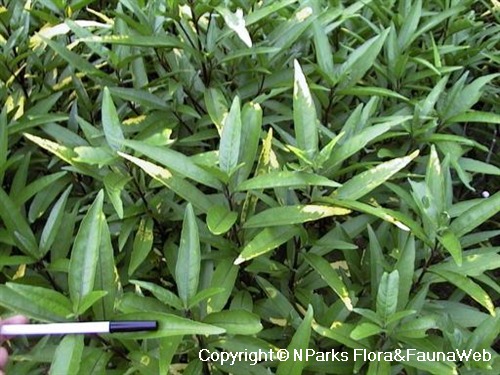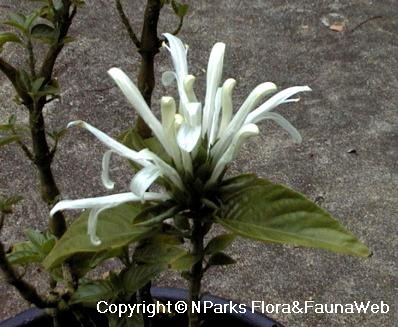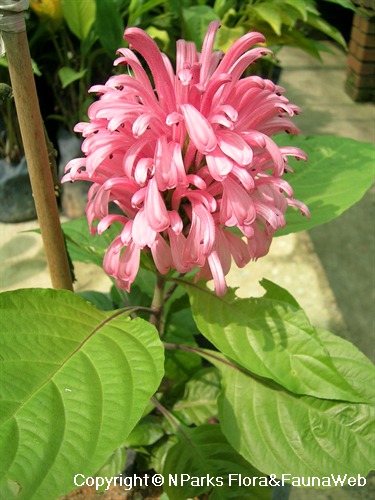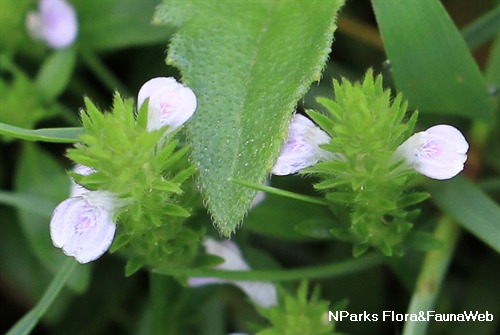
Back
Justicia gendarussa 'Variegata'
| Family Name: | Acanthaceae |
| Synonyms: | Adhatoda subserrata '', Gendarussa vulgaris '' |
| Common Name: | Variegated Gandarus, Variegated Water Willow, Variegated Willow-Leaved Justicia |
Name
Classifications and Characteristics
| Plant Division | Angiosperms (Flowering Seed Plants) (Dicotyledon) |
|---|---|
| Plant Growth Form | Shrub |
| Mode of Nutrition | Autotrophic |
| Maximum Height | 1.5 m |
Biogeography
| Native Habitat | Terrestrial |
|---|---|
| Preferred Climate Zone | Tropical |
Description and Ethnobotany
| Growth Form | A small, erect, fast-growing, branched shrub with attractive, lanceolate (shaped like a lance-head), ascending to spreading variegated leaves in shades of green, white and grey, and produces dainty white flowers. |
|---|---|
| Foliage | Leaves simple, entire, opposite, lanceolate, variegated in shades of white, green and grey, 7 to 14 cm long and 1 to 2.5 cm wide, glabrous on both sides, apex acute-acuminate. |
| Stems | Stems multi-branched, glabrous (smooth; not hairy or rough), terete (having a circular transverse section), thickened at and above the nodes and internodes. |
| Flowers | Inflorescences on spikes, up to 10 cm long and 1.5 cm across; flowers subsessile (with a slight stalk), white with purple streaks and spots inside, 1.6 to 2 cm long. |
| Fruit | Fruit capsules club-shaped, glabrous, 4-seeded, about 12 mm long. |
| Cultivation | It prefers light, sandy soil in sun or partial shade. Likes constant moisture and well draining soil. Fast-growing, tolerable to many soil types and growth conditions, and generally free from pest and diseases. Propogate by stem cuttings and seeds. Prick out seedlings into individual pots when established enough to handle. |
| Etymology | The genus epithet 'Justicia' was named after James Justice, a horticulturalist from Scotland (1730-1763). The derivation of its species epithet 'gendarussa' derivation is obscure, but possibly taken from a local name for this species. |
Landscaping Features
| Desirable Plant Features | Ornamental Foliage |
|---|---|
| Landscape Uses | General, Parks & Gardens, Small Gardens, Flowerbed / Border |
Plant Care and Propagation
| Light Preference | Semi-Shade, Full Sun |
|---|---|
| Water Preference | Moderate Water |
| Plant Growth Rate | Moderate |
| Rootzone Tolerance | Moist Soils, Well-Drained Soils, Fertile Loamy Soils |
| Potential Problems | No serious insect or disease problems. |
| Propagation Method | Stem Cutting |
Foliar
| Foliage Retention | Evergreen |
|---|---|
| Mature Foliage Colour(s) | Green, Silver / Grey, White, Patterned |
| Mature Foliage Texture(s) | Smooth |
| Prominent Young Flush Colour(s) | Green, Silver / Grey, White, Patterned |
| Young Flush Texture(s) | Smooth |
| Foliar Type | Simple / Unifoliate |
| Foliar Arrangement Along Stem | Opposite |
| Foliar Shape(s) | Non-Palm Foliage (Lanceolate) |
| Foliar Venation | Pinnate / Net |
| Foliar Margin | Entire |
| Foliar Apex - Tip | Acute, Acuminate |
| Foliar Base | Acute |
| Leaf Area Index (LAI) for Green Plot Ratio | 4.5 (Shrub & Groundcover - Dicot) |
Floral (Angiosperm)
| Flower & Plant Sexuality | Bisexual Flowers |
| Flower Colour(s) | White |
|---|---|
| Flower Texture(s) | Smooth |
| Flower Grouping | Cluster / Inflorescence |
| Flower Symmetry | Bilateral |
| Inflorescence Type | Spike |
| Flowering Period | Free-Flowering |
| Flowering Habit | Polycarpic |
Fruit, Seed and Spore
| Mature Fruit Texture(s) | Smooth |
|---|
Image Repository
Others
| Master ID | 865 |
|---|---|
| Species ID | 2160 |
| Flora Disclaimer | The information in this website has been compiled from reliable sources, such as reference works on medicinal plants. It is not a substitute for medical advice or treatment and NParks does not purport to provide any medical advice. Readers should always consult his/her physician before using or consuming a plant for medicinal purposes. |




